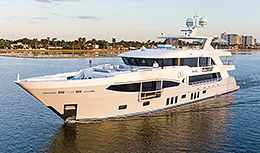- Alaskan Yachts
- Azimut Yachts
- Back Cove Yachts
- Beneteau Yachts
- Benetti Superyachts
- Bertram Yachts
- Boston Whaler
- Broward Yachts
- Buddy Davis Sportfish
- Burger Yachts
- Cabo Yachts
- Catamarans
- Carver Motoryachts
- Center Console
- Chris-Craft Yachts
- Cruisers Yachts
- DeFever Trawlers
- Dufour Sailboats
- Fairline Yachts
- Feadship Yachts
- Ferretti Yachts
- Formula Yachts
- Fountaine Pajot Cats
- Grady-White
- Grand Banks Trawlers
- Hargrave Yachts
- Hatteras Yachts
- Hinckley Picnic Boats
- Horizon Yachts
- Hydra-Sports
- Intrepid Boats
- Jarrett Bay Sportfish
- Jeanneau Yachts
- Kadey-Krogen Trawlers
- Lazzara Yachts
- Lekker Boats
- Luhrs Sportfish
- Marlow Yachts
- Maritimo Yachts
- Marquis Yachts
- McKinna Motoryachts
- Meridian Yachts
- Midnight Express
- MJM Yachts
- Mochi Craft
- Neptunus Motoryachts
- Nordhavn Trawlers
- Nordic Tugs
- Numarine Yachts
- Ocean Alexander Yachts
- Offshore Yachts
- Outer Reef
- Oyster Sailing Yachts
- Pacific Mariner Yachts
- Palmer Johnson Yachts
The Future of Marine Engines
Think beyond internal combustion to see what will make boats go in the future.
Today, whether it be outboard or inboard, gasoline or diesel, the marine engine is a paragon of reliability, cleanliness, and efficiency. I can’t remember the last time I saw an oil leak. But as good as marine engines are, they eventually won’t be good enough. Everyone knows that emissions regulations are only going to get tougher. So what does the future hold for marine engines?
There are two possibilities: Either engineers will continue to devise ways to make gasoline and diesel engines cleaner and more efficient or they’ll hit a wall and turn to new technologies. And what might those be? Prediction is risky. Think back to those earlier days when no one could imagine a gasoline inboard with electronic port fuel injection controlled by an onboard computer or a diesel with electronic injectors and an ultra-high-pressure common-rail fuel system.
We know one thing for sure: For reasons of cost, future engines will be derived from automotive and industrial models. In automobiles, the future seems to be hybrid and pure electric systems. According to the United States Energy Information Administration’s Annual Energy Outlook, as much as 42 percent of new cars will eventually employ regenerative (hybrid), battery-powered start-stop technology to increase fuel economy. Could a similar system replace today’s marine engine?
Hybrids are appealing. A few years back Ferretti built a Mochi Long Range 23 with diesel-electric hybrid propulsion that allowed it to operate in “zero emission mode” for a limited time and under straight diesel power the rest of the time. Greenline developed a similar hybrid system that added a solar collector to help recharge the battery bank. Also Northern Lights offers a propulsion system where a generator keeps a battery bank charged and powering an electric propulsion motor. All are impressive engineering efforts but are not hybrids in the sense of, say, a Toyota Prius, because they lack the regenerative component: They don’t capture energy that is otherwise lost during coasting or braking. When a Prius driver lifts his foot off the accelerator or places it on the brake, the system captures that inertial energy to recharge the battery. Boats do not brake; they halt when the throttles are closed, mostly due to hydrodynamic friction, so marine hybrid systems must charge battery banks either by an onboard generator or shore power. Either way the net energy savings is zero.
Theoretically, you could reverse the propellers and use the resulting force to generate electricity. But notwithstanding the ensuing passenger discomfort, if not whiplash, boats don’t stop-and-go often like cars do, so the potential energy to be captured is small. About the only place where marine hybrid power could capture significant energy is on a sailboat dragging a propeller-driven generator behind it when under sail to recharge its batteries.
Hybrid power is viscerally appealing because we’ve all seen it work on land and because it’s a bridge technology; it involves the familiar internal combustion engine, which increases our comfort level and reduces development costs. But when it comes to marine power, we may have to abandon the internal combustion engine entirely for something different, and that something seems most likely to be the fuel cell.
A fuel cell converts chemical energy directly into electricity by way of a chemical reaction between oxygen and hydrogen. (Hydrocarbons such as coal and natural gas can be used to generate hydrogen.) Fuel cells are clean—their only significant waste products are heat and water—and they’re 40 to 60 percent efficient, compared to about 30 percent for gasoline engines and about 40 percent for diesels. On the down side, since they produce electricity, a vessel must be equipped with electric motors.
You may know fuel cells because NASA uses them to power satellites and extra-terrestrial vehicles, such as the Mars Rover, but the technology cannot be called Space Age: Fuel cells first appeared in 1838. The main issue in marine applications is storing the fuel, i.e. hydrogen gas. To get the same energy density as diesel fuel requires either a very large storage tank or very high pressure—up to 70,000 psi. Obviously there’d be safety issues storing hydrogen at such pressures on any vessel, and even if you could, there’s no fueling infrastructure. You can’t just pull up to your local fuel dock, nor will you be able to any time in the foreseeable future.
But there is a possible solution that could make fuel cells perfect for vessels of all sizes: Hydrogen gas can be extracted from water using electrolysis. The technology exists; the obstacles are size and cost. Most engineers agree that conceptually, a boat that derives its propulsive fuel from the water around it is entirely feasible. Now that’s a future worth looking forward to.




